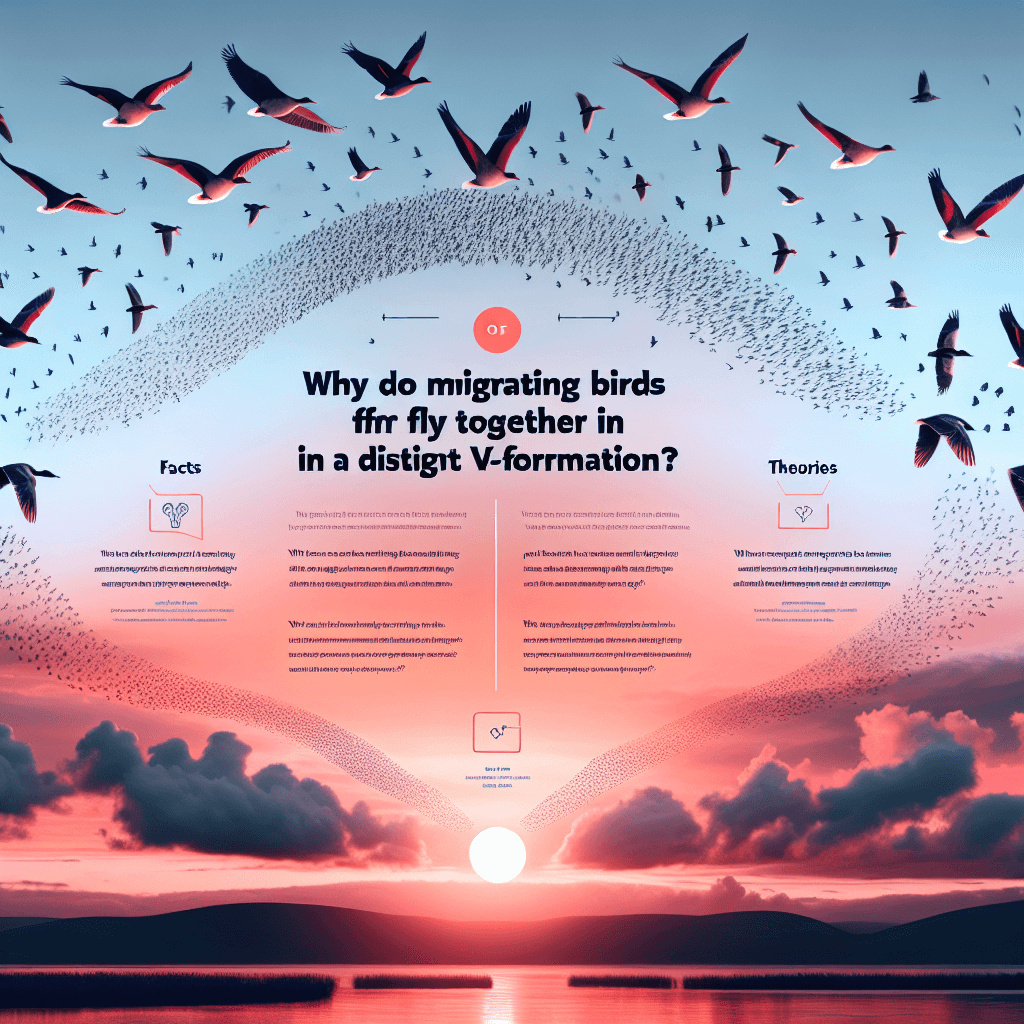The Science Behind the Spectacle: Why Do Migrating Birds Fly in a V-Formation
Ever marveled at the sight of migrating birds flying in a perfect V? This striking natural phenomenon isn't just for show; it's a sophisticated strategy honed by evolution.


Too Long; Didn't Read
Birds fly in a V-formation as a highly efficient, evolutionary strategy to conserve energy during long-distance migration.
The Science Behind the Spectacle: Why Do Migrating Birds Often Fly Together in a Distinct V-Formation?
Have you ever looked up during migration season and marveled at the sight of geese, pelicans, or other large birds flying in a perfect V? It's a striking natural phenomenon, seemingly choreographed against the vast canvas of the sky. But this isn't just an aesthetic choice; the V-formation is a sophisticated strategy honed by evolution. Why do migrating birds often fly together in a distinct V-formation? It’s a question that blends physics, biology, and complex social behaviour. This post delves into the fascinating reasons behind this iconic flight pattern.
The Aerodynamic Advantage: Catching a Free Ride
The primary reason birds fly in a V-formation is rooted in aerodynamics and energy conservation. It's all about making the incredibly demanding task of long-distance migration slightly easier.
- Wingtip Vortices: When a bird flies, the air pressure above its wing is lower than the pressure below, generating lift. At the wingtips, this higher-pressure air spills around to the lower-pressure zone, creating swirling vortices of air. Directly behind the wingtip, the air is pushed downwards (downwash), but slightly off to the side, the vortex creates an area of upward-moving air (upwash).
- Riding the Upwash: Birds flying in a V position themselves precisely to take advantage of the upwash generated by the bird ahead and slightly to the side. Flying in this "sweet spot" gives them extra lift, reducing the effort needed to stay airborne.
- Significant Energy Savings: How much energy does this save? Studies, including research published in journals like Nature involving tracking birds like Northern Bald Ibises with high-tech data loggers, have confirmed the theory. These studies measured heart rates and wing flap patterns, showing that birds in the formation expended significantly less energy than the bird flying at the very front. Estimates suggest energy savings can range from 10% to potentially over 30%, a crucial margin when flying thousands of miles.
Communication and Orientation: Staying Together
While energy saving is paramount, the V-formation offers other benefits crucial for a successful migration.
- Enhanced Visibility: Flying in this staggered formation allows each bird (except the leader) to have a clear field of vision ahead and to the sides. This helps the flock stay together, maintain spacing, and react collectively to changes in direction or potential threats.
- Improved Communication: Birds can easily keep visual track of their neighbours within the V. This facilitates subtle communication through posture or movement, helping coordinate flight adjustments or signal danger.
- Navigational Aid: While birds possess remarkable navigational abilities, flying in a group, potentially led by more experienced individuals, can enhance orientation accuracy. The formation allows younger or less experienced birds to follow the leaders effectively.
Taking Turns: Sharing the Burden
The bird at the front of the V, the leader, doesn't get the aerodynamic benefit. This position requires the most effort as it cuts through undisturbed air. Observations and research have shown that birds don't maintain fixed positions within the V.
- Rotating Leadership: Flocks exhibit remarkable cooperation by rotating the lead position. When the lead bird tires, it drops back into the formation to take advantage of the upwash created by others, and another bird moves forward to take its place.
- Cooperative Behaviour: This sharing of the most demanding role ensures that the burden is distributed throughout the flock, increasing the overall endurance and success rate of the migratory journey for the entire group.
Why Not All Birds Fly This Way?
It's important to note that not all flocking birds use the V-formation. You'll see vast, swirling murmurations of starlings or tightly packed bunches of smaller birds. The V-formation appears most beneficial for larger birds undertaking long, arduous migrations where aerodynamic efficiency is critical. For smaller birds or those not travelling extreme distances, other flocking strategies might prioritize predator avoidance (safety in numbers, confusing predators) or maximizing foraging opportunities over aerodynamic efficiency.
Conclusion: A Masterclass in Efficiency
The sight of birds flying in a V-formation is more than just a beautiful spectacle; it's a testament to evolutionary ingenuity. The answer to "Why do migrating birds often fly together in a distinct V-formation?" lies primarily in sophisticated aerodynamics that allow for significant energy savings. However, the benefits extend to improved communication, visibility, and navigation within the flock. Furthermore, the cooperative sharing of the demanding lead position highlights the complex social dynamics at play. This formation is a remarkable example of how animals adapt their behaviour to overcome immense physical challenges, ensuring their survival across vast distances. It truly is a masterclass in natural engineering and teamwork, perfectly designed for the demanding journeys of migration.


